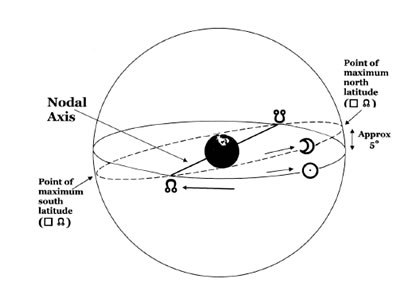The 18.6 year cycle
The 18.6-Year Cycle
Who hasn’t heard of the 18.6-year cycle nowadays? It might be one of the most famous cycles applied to the financial markets, especially on the SP500. It was first heard of in the 1930s by a mysterious figure named Louise McWhirter, a financial astrologer. Therefore this cycle is also known as the “McWhirter Theory”. The reason why Louise McWhirter is a mysterious figure is that there are no other works known of her. Some people even engage with the idea that Louise was an alias for the famous analyst W.D. Gann, who was famous for using time cycles and planetary movements in his analysis and market forecasting.
What is the 18.6-year cycle?
The 18.6-year cycle is a business cycle based on the north node going through the different zodiac constellations. For the north node to complete a full cycle through all of the zodiacs it takes 18.6 years. McWhirter believed that you can determine at which stage the markets are based on the position of the north node.
What is the north node?
The north node is the point in space where the moon meets the ecliptic plane of the earth. The moon has a small deviation from the ecliptic plane of the earth, therefore the moon will meet the ecliptic plane of the earth 2 times. This creates the north and south nodes. These nodes are dynamic and go through the constellations in a cycle of 18.6 years.

The constellations and their meaning during the 18.6-year cycle
The north node takes approximately 1,5 years (about 18 months) to go through 1 constellation of the zodiac. Below you can see the zodiacs and their meaning when the north node passes through them.
 Aquarius: The bottom of the cycle, the “extreme low”
Aquarius: The bottom of the cycle, the “extreme low”
Pisces: The business activity approaches the bottom of the cycle
Aries: The business activity falls below the levels of “normal” approaching the bottoming period
Taurus: Trend is going down. Business levels are at “normal”
Gemini: The business continues to falls lower, direction to “normal”
Cancer: The business cycle moves away from the top into a downtrend
Leo: The top of the cycle
Virgo: The business cycle goes higher
Libra: Business cycle goes above “normal” levels
Scorpio: Business cycle at normal levels and the trend is upwards
Sagittarius: Business goes higher, direction to normal levels
Capricorn: Business cycle moves up from the bottom
Most recent market tops and bottoms compared to the McWhirter theory
In March 2020 the north node left Leo, entering Cancer and this month marked the exact top of the DOTCOM bubble. Afterward, the markets had a major correction. In January 2008, the north node left Pisces going into Aquarius which is the period it should mark a major bottom in the stock market. In March 2009 we had a major low in the SP500 which was during the period when the north node was in Aquarius. This marked the end of the housing market crisis. In August 2015 the north node left Virgo into Leo and we’ve seen a major sell-off afterward in the stock markets. Again, showing a clear top which took over a year to fully recover.
Where are we now in the 18.6-year cycle?
The north node currently is in Taurus which tells us the economic activity in this part of the cycle is slowing down going back to “normal” levels. That doesn’t mean that the stock can’t make new highs, even when the economy is slowing down we still could see market rallies, however, these are not that sustainable and quickly enter overbought conditions and have less potential than rallies in Sagittarius for example.
Future expectations based on the 18.6-year cycle
A recession will start by late 2024, the 18.6-year cycle points to quite a heavy recession. By 2026 the north node will be in Aquarius which marks the end of the business cycle and an “extreme low” and very likely finishing another financial crisis. That also means that after 2026, the markets during the coming years can pick up again and reach normal levels at around 2030.
Extra notes on the 18.6-year cycle
Although this cycle has been very accurate in the past in predicting certain market conditions we do have to take into consideration the devaluation of money by the increase of the money supply. It’s still possible for the market to rise in times of economic stagnation due to the increase in the money supply. But this cycle does help to give a rough estimate of which periods you can expect major highs and major lows in the financial markets.